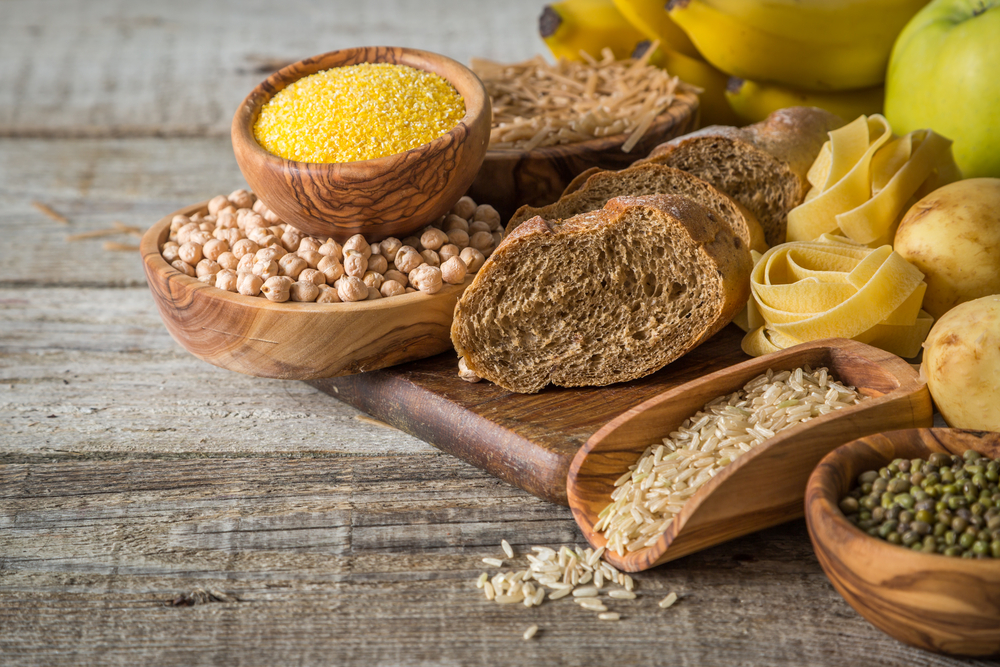Can a person with diabetes eat carbohydrates? Yes!
When it comes to carbohydrates and diabetes, there’s a few steps in the journey to understanding carbohydrates and the role they play.
The first step is to understand what carbohydrates are.
What are carbohydrates?
Carbohydrates or Carbs are important because they can have a huge impact on your blood glucose levels if you have type 1 diabetes, type 2 diabetes or borderline prediabetes.
Carbohydrates are molecules that contain exactly what their name suggests carbon and hydrogen and
oxygen. Mostly carbs are made by plants through a process called photosynthesis where the following reaction
takes place:
Carbon dioxide (CO2) + water (H2O) = Oxygen(O2) + Carbs (CH2O)
As you seen this equation is fairly important in the world as oxygen is created as a by-product and that is the
basis of life on Earth.
A very good way to remember which foods contain carbohydrates is to think about foods that come from plants
like fruit, seeds and grains. The other major source of carbohydrates is dairy foods. Generally dairy foods
contain carbohydrate in the liquid parts. There is carbohydrate in milk but no carbs are in cheese.
Here are some key points about carbohydrates. Carbohydrates are:
- One of the 3 major food groups – the others are protein and fat
- Essential for your health and nutrition
- The main energy source for our body – our brain uses glucose as its primary energy source
- Found in most foods, including fruits and vegetables, breads and cereals, sweet dessert foods like cake, biscuits, and lollies
What is the difference between carbohydrates and sugars?
You might have heard people talk about sugar and diabetes. Sugar is actually one form of carbohydrate! In addition to sugars, other forms of carbohydrates include starches and some types of dietary fibre. Let’s look at these in a little more detail.
Sugars:
Sugars are also referred to as simple carbohydrates. Types of sugars include:
- Glucose – e.g. in fruit, some vegetables, honey
- Fructose – e.g. in fruit and honey
- Sucrose – e.g. in sugar cane
- Lactose – e.g. in milk (excluding milks made from animal sources), including breast milk
- Maltose – e.g. malted grains like malted barley
Starches:
Starches are also referred to as complex carbohydrates. These molecules are used by plants as a source of
long term storage and are found in grains and seeds. Flour is used to make bread and pasta and is produced from
wheat seeds.
Examples of starches include:
- Breakfast cereals
- Legumes
- Potatoes
- Rice
- Flour making bread, pasta, cakes and biscuits
Dietary Fibre:
Some carbohydrates made by plants are strongly bound together and help create the structures of the plant like stems, leaves and flowers. Humans are not able to break down these strong bonds and generally pass through us without being digested. These structural carbohydrates are known as fibre.
Dietary fibre is found in many plant-based foods and comes in the form of soluble fibre and insoluble fibre.
Why should I care about carbs? How do they affect my diabetes?
When we eat food, our digestive system will break it down to use for energy, among other things. So, when we eat foods that contain carbohydrates, our body will break down the carbohydrates into glucose, regardless if it is sugar or starch.
Glucose is one of the simplest forms of sugar and when it enters the blood stream, it raises our blood glucose levels. This causes the pancreas to release insulin to help the body absorb glucose to be used for energy. After glucose moves from the blood stream and into our cells, your blood glucose levels go back to normal.
The effect that carbohydrates have on your blood glucose levels, depends on what type of carbohydrates you eat, and how much you have. Even though carbohydrate foods impact your blood glucose levels, they can definitely be incorporated into a healthy diet. If you have diabetes understanding where carbohydrates are from and the portion or amount of carbohydrates in a particular food is essential.
While everyone’s carbohydrate needs are different. How much carbohydrates you have in a day can depend on what type of diabetes you are, how old you have, how active you are, and whether you’re trying to lose weight.
Depending on what your needs are, it’s good to spread your carbohydrate intake across the day, as having too much at any one time can cause a rapid spike in your blood glucose levels.
Can I still eat cookies and other sweet foods?
Energy dense foods have a big impact on our blood glucose levels. These foods are called ‘discretionary foods,’ ‘sometimes foods,’ or most commonly ‘junk food’! Examples of energy dense foods include lollies, cakes, soft drink, chocolate, and flavoured milks. As well as being high in carbohydrates, they are often high in fats and salt. As part of a healthy diet, we should be limiting the amount of energy dense foods that we eat every day. If you are someone that eats a lot of these types of foods, you should consider reducing your intake, especially if you have diabetes as this will greatly help your blood glucose levels.
It can certainly be hard to make a lot of changes all at once, so it is important to focus on one at a time, and to think about what changes are feasible for you. Often, people who quit a habit cold turkey can’t sustain the change for very long and will easily fall back into old habits. This is why it’s important to understand that change can take time and it won’t happen overnight. For example, you might be someone that eats a lot of cookies and you’ve been doing this for years. If you eat five cookies in one day, think about reducing that to three or four cookies in a day for one week, and then down to one or two in the next week. This gradual change will help ensure that changes you make are for the long term.
Are there any foods that I can have that won’t affect my blood glucose levels?
Yes, there are! We refer to foods that have little to no carbohydrates, as carbohydrate free foods.
Carbohydrate free foods are those foods that have little effect on blood sugar levels and can be consumed without extra insulin. You don’t need to avoid eating carbohydrate free foods. They can be eaten between meals as ‘free’ snacks or with carbohydrate foods (e.g. potato, rice, pasta) with your main meals.
Some examples of low carbohydrate foods include:
- Salad vegetables – e.g tomato, cucumber, and lettuce
- Broccoli, cauliflower, mushrooms, beetroot
- Fresh or frozen berries (in small amounts, e.g. a small handful)
- Fresh meat – choose lean cuts and remove all the fat
- Cheese – choose low fat
- Herbs and spices used in cooking
How can I include carbohydrates into my diet?
With a little bit of meal planning, you can certainly include carbohydrates in your every diet. This includes starchy foods, like potatoes!
When including carbohydrates in the diet, it’s best to:
- Choose wholegrain breads and cereals, i.e. brown bread over white bread
- Choose whole pieces of fruit over fruit juice – there’s more fibre in a whole piece of fruit compare to a glass of juice
Now that we understand carbohydrates a little more, let’s have a look at carb counting and carb portions.
What is carb counting?
Carbohydrate counting, or carb counting, is a method of calculating the grams of carbohydrate consumed at meals and snack times. As I’ve mentioned, when you have diabetes, the carbohydrates that you eat can have the greatest effect on your blood glucose levels. By counting how much carbohydrate you have across a day, can really help you with managing your blood glucose levels and to keep them in a normal range. Also, by spreading your carbohydrate foods evenly across the day, can help maintain your energy levels and keep your blood glucose levels within your target range.
What are carbohydrate portions?
In a person with diabetes who takes insulin, you will need to consider what foods you are eating, and how much carbohydrate are in those foods. Understanding carbohydrate portions can make this a whole lot easier.
One serving of carbohydrate is measured as 15 grams. A food that contains 15 grams of carbohydrate is also called “one portion of carbohydrate” or simply “one portion.” You can use portions of carbohydrates to help with your carb counting.
Your doctor may set you an amount of allowable amount of carbohydrates you can consume in a day, this will depend on your age, if you’re trying to lose weight, and your activity levels. Generally speaking, Dr Sultan recommends 10-12 portions for men and 6-9 portions for women.
Let’s look at a brief example: Dr Sultan may recommend for you to have 10 portions of carbohydrates across the day. 10 portions are equal to 150g of carbohydrate. Knowing that you can have 10 portions can make it easier for you to spread your carbohydrates evenly throughout the day. It may also help to prevent you from going overboard and having too many carbohydrates, which could cause a spike in your blood glucose levels.
Example of allowable carbohydrates per day: 10 portions or 150g
| Breakfast | Morning Tea | Lunch | Afternoon Tea | Dinner | Supper |
|---|---|---|---|---|---|
| 3 portions | 1 portions | 3 portions | 1 portions | 2 portions | 0 portions |
Check out How to reduce carbohydrates in your diet.
The bottom line:
- Carbohydrates can be included in a healthy diet, even if you have diabetes
- Learn which foods have carbohydrates in them and how much, as this will help you with counting carbs
- Reduce your intake of energy dense foods, like cakes, lollies, and soft drinks
- Spread your carbohydrate intake evenly across the day
If you have heard of the “Diabetic Diet,” we have written an article about it. If you’re interested in history, check out our article that includes when it began and how it has changed.
If you want to learn more about diabetes, we have dedicated information pages:
Carbohydrate counting and understanding how many carbohydrate portions you should eat in a day, is covered in our 12-week program. The program is personalised, giving you more of the content that you want to see. When you sign up, you receive the first week free!
Interested in more videos and articles about food and diabetes? Here’s a selection of more articles you may be interested in.
- Yo-Yo Dieting – More serious than just gaining weight!
- Diabetes and diet in pregnancy
- Should I follow a low carb diet if I have diabetes?
- Is fruit juice good for you if you have diabetes or prediabetes?
- Low sugar high carb cereals compared



